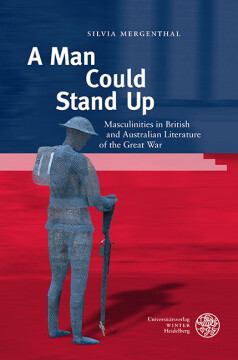
BUCH
A Man Could Stand Up
Masculinities in British and Australian Literature of the Great War
Anglistische Forschungen, Bd. 472
2022
Zusätzliche Informationen
Bibliografische Daten
Abstract
This book explores imbalances of power between male and female characters, and the interplay between fictional masculinities, in British and Australian fiction of the First World War. While most of the novels under consideration were written during the war itself and in the interwar period, others take Stock of what it means to be a man in times of war on the occasion of WWI anniversaries, including the 2014-2018 centenary. These more recent novels draw upon repositories of sedimented images stored in archives of cultural memory, thus raising the question of how the Great War is inscribed in national imaginaries. Hence, some chapters will also discuss Australian texts as they serve to demonstrate, even more clearly than their British counterparts, how constructions of masculinity intersect with constructions of national identity. Finally, in some fictional subgenres such as adventure novels, it is their indebtedness to literary traditions which engender specific types of masculinity.
Inhaltsverzeichnis
| Zwischenüberschrift | Seite | Aktion | Preis |
|---|---|---|---|
| Cover | Cover | ||
| Titel | 3 | ||
| Imprint | 4 | ||
| Acknowledgements | 5 | ||
| Table of Contents | 7 | ||
| 1 Introduction | 9 | ||
| 2 The Soldier's Tale Template and Some Variations. Richard Aldington, ‚Death of a Hero‘ (1929), Frederick Manning, ‚The Middle Parts of Fortune‘ (1929), Evadne Price, ‚Not So Quiet: Stepdaughters of War‘ (1930) | 23 | ||
| 3 Turning Men Into Soldiers. Ian Hay, ‚The First Hundred Thousand‘ (1915), A.P. Herbert, ‚The Secret Battle‘ (1919) | 39 | ||
| 4 Same-Sex R. Ernest Raymond, ‚Tell England: A Study in a Generation‘ (1922), Rose Allatini, ‚Despised and Rejected‘ (1918) | 51 | ||
| 5 Shell Shock. Rebecca West, ‚The Return of the Soldier‘ (1918), Gilbert Frankau, ‚Peter Jackson, Cigar Merchant‘ (1920) | 63 | ||
| 6 Non-Combatants and Others. H.G. Wells, ‚Mr Britling Sees It Through‘ (1916), John Galsworthy, ‚The Burning Spear‘ (1919) | 79 | ||
| 7 The Reciprocal Gaze. May Sinclair, ‚The Romantic‘ (1920), Cicely Hamilton, ‚William, an Englishman‘ (1919), Irene Rathbone, ‚We That Were Young‘ (1932) | 91 | ||
| 8 Gender and Genre. John Buchan, ‚Mr Standfast‘ (1919), Warwick Deeping, ‚The House of Adventure‘ (1921) | 115 | ||
| 9 Theatrical Interlude. Joan Littlewood, ‚Oh What A Lovely War‘ (1963), Alan Seymour, ‚The One Day of the Year‘ (1960) | 131 | ||
| 10 Anzac Musters. William Baylebridge, ‚Anzac Musters‘ (1921), Leonard Mann, ‚Flesh in Armour‘ (1932) | 145 | ||
| 11 Historical Interlude. Bill Gammage, ‚The Broken Years‘ (1974), Paul Fussell, ‚The Great War and Modern Memory‘ (1975), Eric J. Leed, ‚No Man's Land: Combat and Identity in World War I‘ (1979), Elaine Showalter, ‚The Female Malady: Women, Madness and English Culture‘ 1830-1980 (1985) | 167 | ||
| 12 A Tale of Two Stephens: British and Australian Commemorative Fiction. Sebastian Faulks, ‚Birdsong‘ (1993), Peter Yeldham, ‚Barbed Wire and Roses‘ (2007) | 185 | ||
| Bibliography | 203 | ||
| Backcover | Backcover |


 Publishing Platform by CloudPublish
Publishing Platform by CloudPublish